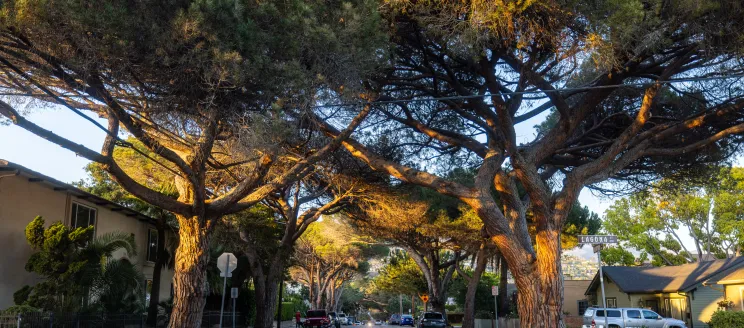
Pruning and Removal of Select Anapamu Street Italian Stone Pines to Begin Next Month
The City of Santa Barbara’s Urban Forestry staff will remove five Italian stone pines on East Anapamu Street after a comprehensive assessment identified the aging trees as a threat to public safety. Several of the remaining trees will receive canopy pruning to reduce the risk of limb failure once neighboring trees are removed. Removals are expected to begin the week of June 3, following a nesting bird survey.
Between March 29 and March 30, two Italian stone pines on East Anapamu Street failed. Three additional trees later required emergency removal due to the risk of imminent failure. While the trees are regularly monitored due to their age and size, a comprehensive tree risk assessment evaluated the overall health and structural stability of each Italian stone pine and identified five trees with dead and decaying roots, requiring full removal. Seven trees are in an irreversible decline in health but were not identified as high-risk and are not currently scheduled for removal. Urban Forestry staff will continue to monitor these trees.
The mature trees were planted in 1908 and 1929 and have been weakened by a combination of factors, including drought, disease, and development over the past century. When the trees were planted, East Anapamu Street was a wide, unpaved road. Today, the trees are in parkways ranging from 4-6 feet. The large lateral roots of the Italian stone pines cause damage to nearby asphalt and concrete, lifting sidewalks and damaging roads. As repairs are made to the surrounding hardscape, the roots of the trees are pruned, weakening the tree. Aggressive canopy pruning to accommodate overhead utility lines places additional stress on the mature trees.
Recent lab testing identified Phytophthora root rot in the soil of all tested trees. This fungal pathogen kills a tree’s roots, first infecting small fibrous feeder roots before moving into larger roots of the tree. Infected feeder roots impact the tree’s ability to uptake water and nutrients, leading to overall decline. Given the pathogen’s ability to easily spread from one location to another, it is presumed to be present in each of the parkways. Lab testing also identified Diplodia tip blight within the canopies of tested trees. This fungal pathogen causes the decline and death of portions of the tree canopy over time.
Urban Forestry staff will develop recommendations for replanting, including consideration of whether the Italian stone pine should remain as the designated street tree or whether there are other tree species that would successfully re-establish the canopy while honoring the City’s horticultural legacy. This process will include review and discussion during public meetings with the Historic Landmarks Commission, Street Tree Advisory Committee, and Parks and Recreation Commission.
Visit SantaBarbaraCA.gov/StonePines for more information, including answers to frequently asked questions.
